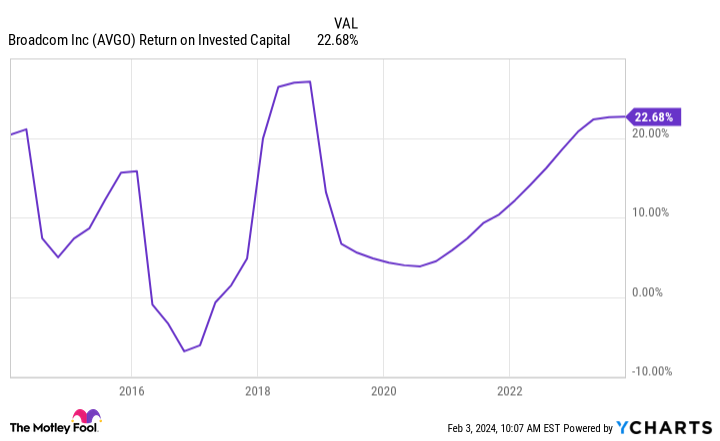Tech giant Broadcom (AVGO -1.65%) has grown into one of the world’s largest companies, expanding beyond semiconductors to enterprise software solutions, punctuated by its recent $61 billion acquisition of VMware. Today, the stock’s valuation approaches $600 billion.
The company’s chips are essential in several end markets, and the business is recognizing a boost from artificial intelligence (AI) spending. Investors looking for a growing blue-chip stock with long-term total return potential should strongly consider the stock.
But with shares at all-time highs, buying today comes down to whether the valuation still makes sense.
I dug through the company’s fundamentals and future outlook to find an answer.
An evolving business
Until recent years, Broadcom’s business was concentrated in semiconductors. It specializes in ASIC, which stands for application-specific integrated circuits. In other words, these chips are designed for one specific job, which makes them excellent and efficient at what they do. Broadcom’s chips are used in connectivity applications, including networking, wireless communications, personal electronics, automotive, and industrial applications.
Image source: Getty Images.
Management has invested heavily in diversifying Broadcom, pushing it into enterprise software. The company acquired CA Technologies in 2018 ($18.9 billion), Symantec’s enterprise security business in 2019 ($10.7 billion), and VMware in 2022 ($61 billion). Broadcom’s software solutions span security, mainframes, cloud computing, and storage area networking. The business is now split roughly 60/40 between semiconductors and IT solutions.
How successful have the acquisitions been?
The big concern with acquisitions is whether they create value for the business. A company could overpay on an acquisition, or the pieces might not go together as well as management hopes. Comparing a company’s weighted average cost of capital (WAAC) to its return on invested capital (ROIC) shows how well it creates value for investors.
In other words, it’s good when a business can make more on the resources it deploys than it costs to acquire them.
You can see below that Broadcom’s ROIC has been somewhat volatile, which is understandable when there’s been so much change within the company. But I like that it recovered back to nearly 23%. Meanwhile, Broadcom’s current estimated WAAC is 11%. That positive 12-point spread between the two signals that Broadcom is creating value in the business as it grows.
AVGO Return on Invested Capital data by YCharts
This is something to watch, but it helps explain how the stock has done so well. Shares are up 440% over the past five years, easily outrunning the S&P 500.
Is the stock a buy today?
Looking at Broadcom’s past performance helps instill confidence that it’s a quality company that generally does well for investors. After all, you don’t accidentally become a nearly $600 billion behemoth. However, the stock’s valuation will play a part in how it performs for shareholders in the future.
Management recently commented that increased demand for chips as customers invest in AI helped drive growth. However, Broadcom’s overall revenue growth was just a 5% year-over-year bump and fourth-quarter guidance called for a 4% bump over the prior year’s Q4. It’s excellent that Broadcom is seeing AI tailwinds, but investors should keep expectations realistic since it’s not dramatically moving the company’s broader figures.
Analysts believe the company will earn $46.91 per share in its fiscal 2024 year, which ends in October. That values the stock at a forward price-to-earnings (P/E) of 26 today. Looking further out, consensus long-term estimates predict 14% annual earnings growth. I like to use the price/earnings-to-growth (PEG) ratio to see how much I’m paying for a company’s future growth, and at a ratio of just under 2, Broadcom isn’t cheap.
It’s not eye-poppingly expensive, as I generally look to buy when that ratio is 1.5 or less. However, investors may consider exercising some patience for a market pullback before pulling the trigger, or purchasing a little at a time while waiting for a better price.




